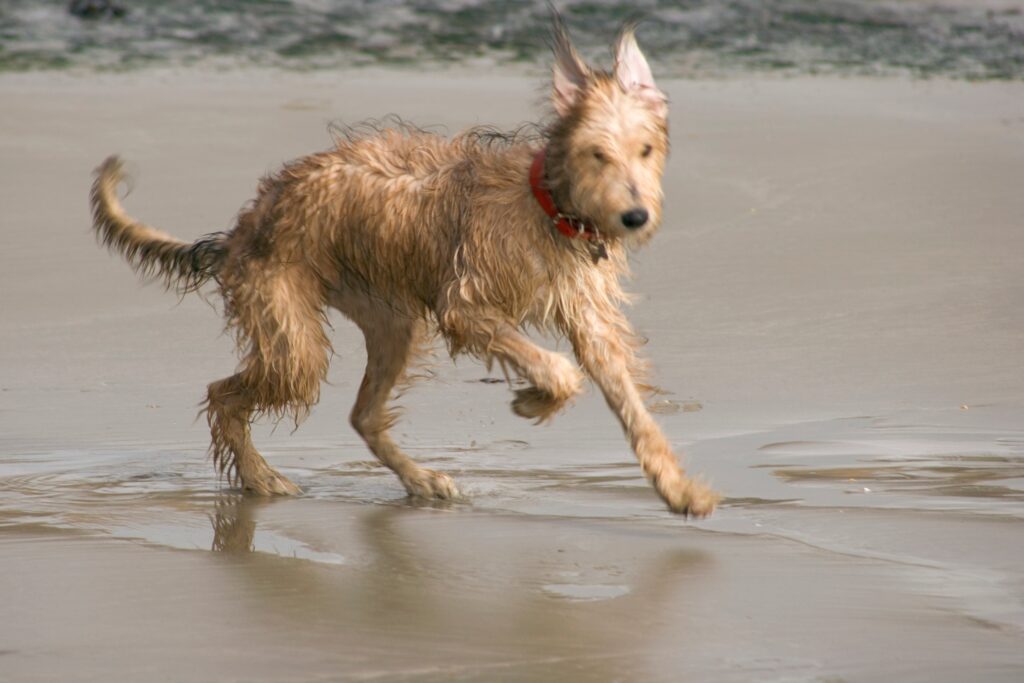How Fast is a Bedlington Whippet: A Comprehensive Look at the Speed of This Hybrid Breed
Bedlington Whippets are known for their speed and agility. On average, they can reach up to 35-40 miles per hour (56-64 kilometers per hour), making them one of the fastest dog breeds. However, it’s important to note that each dog is unique, and factors such as age, health, training, and genetics can all impact their speed and athleticism. Terrain, weather conditions, and the dog’s activity can also affect their speed.


Table of Contents
Key Takeaways
- Bedlington Terriers can reach speeds of up to 30 miles per hour.
- Factors such as genetics, age, weight, and health can influence a Bedlington Terrier’s speed.
- Adequate exercise and training can help maintain a Bedlington Terrier’s speed and overall health.
Bedlington Terrier Speed


The Bedlington Terrier is a small dog breed that is known for its speed and endurance. While the exact speed of a Bedlington Terrier can vary depending on various factors such as age, weight, and overall health, they are generally considered to be a fast breed.
Bedlington Terriers are “noteworthy for endurance” and can “gallop at great speed.” This suggests that Bedlington Terriers are not only fast but also capable of maintaining their speed over long distances.
One study on the elbow joint in domestic dogs and wild carnivores found that the selective regimes for fast running versus fighting are the opposite because fast speed in dogs is associated with the evolution of relatively stiff and brittle bones. This suggests that the Bedlington Terrier’s bone structure may have evolved to support their speed.
It is important to note that while Bedlington Terriers are generally considered to be a fast breed, individual dogs may vary in their speed. Factors such as age, weight, and overall health can all impact a dog’s speed and endurance.
Factors Influencing Speed
The Bedlington Terrier is a breed of small dog that is known for its speed and agility. Several factors can influence the speed of a Bedlington Terrier, including:
- Genetics: The Bedlington Terrier is a breed that has been selectively bred for speed and agility. This means that genetics play a significant role in determining how fast a Bedlington Terrier can run. However, it is important to note that not all Bedlington Terriers will have the same level of speed, as individual genetics can vary.
- Muscle Mass: The amount of muscle mass that a Bedlington Terrier has can also influence its speed. Dogs with more muscle mass tend to be faster than those with less muscle mass. However, it is important to note that too much muscle mass can actually slow a dog down, as it can make it less agile.
- Size and Weight: The size and weight of a Bedlington Terrier can also influence its speed. Generally, smaller dogs are faster than larger dogs, as they have less weight to carry. However, it is important to note that larger dogs can still be fast if they are well-muscled and have good genetics.
- Training: Proper training can also help a Bedlington Terrier to run faster. Regular exercise and training can help to build up a dog’s endurance and speed. Additionally, training can help to improve a dog’s agility, which can make them faster on the agility course.
Comparative Analysis


Bedlington Terrier vs Greyhound
Bedlington Terriers are known for their speed and agility. However, when compared to Greyhounds, they are not as fast. Greyhounds are one of the fastest dog breeds and are capable of reaching speeds of up to 45 miles per hour. Bedlington Terriers, on the other hand, have a top speed of around 30 miles per hour.
Bedlington Terrier vs Border Collie
Border Collies are not typically known for their speed, but they are incredibly agile and have excellent endurance. Bedlington Terriers are faster than Border Collies, but Border Collies are more efficient when it comes to running long distances. Bedlington Terriers have a top speed of around 30 miles per hour, while Border Collies have a top speed of around 20 miles per hour.
Bedlington Terrier vs Beagle
Beagles are not known for their speed, but they are excellent at tracking and hunting. Bedlington Terriers are faster than Beagles, but Beagles are more efficient when it comes to tracking scents. Bedlington Terriers have a top speed of around 30 miles per hour, while Beagles have a top speed of around 15 miles per hour.
In summary, while Bedlington Terriers are known for their speed, they are not the fastest dog breed. When compared to Greyhounds, they are slower, but they are faster than Border Collies and Beagles. It is important to note that speed is not the only factor to consider when choosing a dog breed, and other qualities such as temperament and trainability should also be taken into account.
Speed Training for Bedlington Terrier
Bedlington Terriers are known for their speed and agility. These dogs are excellent runners and can reach impressive speeds. However, like any other breed, they require proper training to reach their full potential.
When it comes to speed training for Bedlington Terriers, there are a few things to keep in mind. First, it’s important to start training them at a young age. Puppies are more receptive to training and can develop good habits early on.
One effective training method is interval training. This involves alternating between periods of high-intensity exercise and periods of rest. For example, you can have your Bedlington Terrier sprint for 30 seconds, followed by a 30-second rest period. This type of training can improve their speed and endurance.
Another important aspect of speed training is proper nutrition. A balanced diet that includes high-quality protein and complex carbohydrates can provide the energy your dog needs to perform at their best. Consult with a veterinarian to determine the best diet for your Bedlington Terrier.
It’s also important to give your dog plenty of opportunities to exercise. Regular playtime and walks can help maintain their overall fitness and improve their speed.
Effects of Speed on Bedlington Terrier’s Health


Bedlington Terriers are a breed of dog that is known for its speed. They are capable of running at great speeds, which makes them excellent racing dogs. However, it is important to consider the effects of speed on their health.
When a Bedlington Terrier runs at high speeds, it puts a lot of strain on its joints and muscles. This can lead to injuries such as sprains, strains, and tears. Additionally, the high impact of running can cause damage to their bones and joints over time, leading to conditions such as arthritis.
It is important to ensure that Bedlington Terriers receive proper training and conditioning to prevent injury. This includes gradually increasing their speed and distance over time, as well as providing them with adequate rest and recovery time between runs.
In addition to physical injuries, high-speed running can also have an impact on a Bedlington Terrier’s cardiovascular health. While regular exercise is important for maintaining a healthy heart, excessive or intense exercise can lead to heart problems such as arrhythmia or heart failure.
Therefore, it is important to monitor a Bedlington Terrier’s heart rate during exercise and ensure that they do not exceed their safe threshold. This can be done using a heart rate monitor or by monitoring their breathing rate and level of fatigue.
Exercise and Activity Level
Ideal Exercise
Bedlington Whippets are a highly active breed that needs a lot of activity to stay healthy and happy. They mix two highly athletic breeds, the Bedlington Terrier and the Whippet, so they need plenty of opportunities to burn off their energy.
The ideal exercise for a Bedlington Whippet includes long walks, runs, and playing fetch. They also like doing dog sports, including agility, flyball, and lure coursing. These activities provide physical and mental stimulation, which is important for the breed’s overall well-being.
Activity Requirements
Bedlington Whippets require at least 60-120 minutes of exercise per day. This can be achieved through walks, runs, and playtime. They also enjoy exploring new environments, so taking them on hikes or to new places can be a great way to keep them active and engaged.
It is important to note that Bedlington Whippets are sensitive to extreme temperatures. They do not do well in hot weather, so exercise should be limited during the hottest parts of the day. In addition, they should not be left outside in cold weather for extended periods. Several activities can help increase a Bedlington Whippet’s speed and agility:
- Running: Regular running and exercise can help build muscle tone and endurance, improving speed.
- Lure coursing: According to American Kennel Club, this activity involves chasing a mechanical lure around a course, which can help improve a dog’s speed and agility.
- Agility training: Agility courses, which include obstacles such as jumps, tunnels, and weave poles, can help improve a dog’s speed, agility, and overall athleticism.
- Flyball: This team sport involves racing over a series of hurdles, retrieving a ball, and returning to the starting line. It can help improve a dog’s speed, agility, and coordination.
- Sprint training: Focused sprint training, such as short sprints with frequent rest periods, can help improve a Bedlington Whippet’s speed and power.
